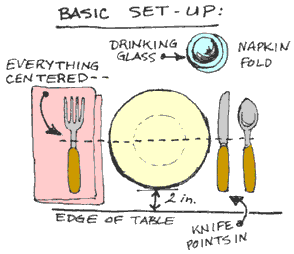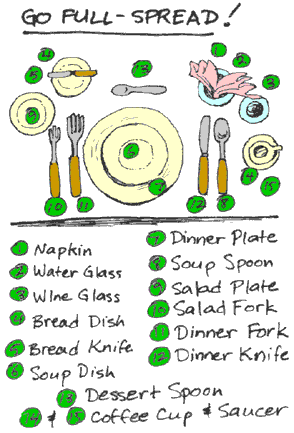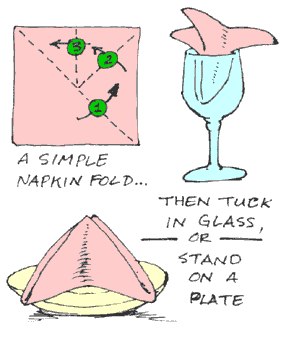| Don't drink from the fingerbowl!
You've just invited the boss to dinner at your house, and TV trays just
won't do. Or you want to impress that special someone with a hot, home-cooked
meal, but can't remember which side the fork goes on.
Never fear. Here are some basic guidelines and rules of etiquette to
setting tables from intimate tête-à-têtes to banquets
for a crowd. Some forethought and organization will allow you and your
guests to spend the dinner hour enjoying food and conversation rather than
navigating the flatware.

The basic placesetting discussed here has been developed over centuries
of European and American dining. Some differences exist from country to
country and even family to family and are often argued with remarkable
passion. Still, a few basic guidelines are generally accepted and will
be adhered to in most American banquet halls.
We'll talk about three types of placesettings: a basic setting, a formal
banquet setting and variations on folding the napkins.
 Check
what you have Check
what you have
Take out the flatware, dishes, glassware and tablecloth or placemats
that you intend to use. Are they dusty? Soiled from the last time you used
them? More often, the worst culprit will be a little dust. Take a clean
dish towel and rub the dust from glasses and plates. Use a polishing cloth
to shine up your flatware.
If you use a tablecloth, make sure it's clean and pressed. You do not
want any stains to remind visitors of last year's Christmas dinner. Inspect
your tablecloth, placemats and napkins early to be sure they are presentable.
Give yourself time for a last-minute wash if needed.
 Understand
the basics Understand
the basics
Rule 1. Everyone at the table gets a placesetting, whether
or not they intend to eat. Anyone can change their mind at the last minute,
and only a careless host or hostess would be caught unprepared.
Rule 2. Flatware is placed evenly on either side of the plate
in a manner comfortable to use by a right-handed person (sorry lefties,
this one never varies). Forks go on the left, knives and spoons on the
right. The cutting edge of the knife should point towards the plate. Spoons
go to the outside of knives.
Rule 3. Place the flatware in the order it will be used,
with the first utensils set furthest away from the plate. The idea is to
avoid rooting around for the appropriate fork or confusing your guests.
 Master
the standard placesetting Master
the standard placesetting

It may take a bit of fussing around the first few times out, but nothing
impresses a guest so easily as a perfectly set table. Chalk it up to the
communal nature of mankind, or synchronicity or tribalism or whatever,
but a precisely set banquet of multiple settings creates a wonderful atmosphere.
Even if it's just you and a guest, a placesetting helps you feel important
on that special occasion when you turn off the television set and eat in
the dining room.
-
If you have placemats: set each one square to the edge of the table
where each chair will be. The bottom of the placemat (the side closest
to the chair) should be about an inch (2.5 cm) from the edge of the table.
Although this distance may vary from occasion to occasion, every placesetting
at a table or banquet should be exactly equal to every other placesetting.
-
The dinner plate (the big one) goes dead center in the middle of the placemat,
or put the bottom of the plate two inches (8 cm) from the edge of the table
if you are using a tablecloth. The napkin goes lengthwise on the left side
of the plate. Fold square napkins once to make them rectangles, then lay
them in the same direction the utensils will go. The crease goes next to
the plate.
-
Each utensil should be about a half-inch (2 cm) away from the plate and
from each other. The fork goes on the left, tines up (the pointy ends),
on top of the napkin; the knife goes on the right, cutting-edge towards
the plate. Place the spoon next to the knife, parallel and to the right.
-
The drinking glass goes above the knife, about two inches away from the
tip.
 Master
the formal placesetting Master
the formal placesetting

Generally, the more formal the occasion, the more courses are served,
which of course means more flatware. There should be a different set of
utensils for each course: salad fork, dinner fork; dinner knife, bread
knife; and so on.
Some special dishes such as oysters have special utensils. These can
be served at the presentation of the food, but generally are placed on
the table in order of course. When oysters are served as an appetizer for
example, set the oyster fork to the right of the spoon.
Building from the basic set-up (see above), the following utensils may
be added.
-
On the left side of the plate put the salad fork to the left of the dinner
fork. On the right add a soup spoon to the outside of the dinner spoon
if soup will be served. Place the soup bowl above the soup spoon and to
the right. The bread plate goes to the left, about two inches above the
fork. Place the butter knife across the bread plate at a diagonal, upper
left to lower right. Small salad plates go to the left and a little below
the bread plate. Dessert spoons, or in some cases knife and fork, are placed
about an inch above the top of the plate with the handle(s) on the right
side.
The largest glass on the table is the water glass (see above for basic
placement). It may be filled and iced when guests arrive or left empty
to be filled at each diner's request. If wine or some other beverage is
served, set the appropriate glass to the right and a little down from the
water glass.
 Master
the napkin variations Master
the napkin variations
One way to vary table settings is through napkin folding -- an art in
itself -- and placement. Try one of the following simple and exotic variations
when you really want to show off.

Two simple, effective techniques:
-
The Fan: Open each napkin completely and lay it flat on the table.
Fold napkin back and forth like a fan, then press it down so the creases
are sharp. Fold the long rectangle in half and place the center in an empty
water glass. Open the two ends of the napkin sticking out of the glass
in fan shapes. Set the glass in its original placement (see above) or directly
in the middle of the dinner plate.
-
The Triangle: An even easier method is to open the napkin flat and
fold one corner on top of its opposite corner. Take one of the other corners
and fold it over onto its opposite. Fold these corners on top of the other
ones and crease. Take the corner of the resulting triangle (which used
to be the center of the napkin) and place into an empty water glass. Or
you can open up the folded triangle a little and set it directly on the
dinner plate.
 Adapt
to your circumstances Adapt
to your circumstances
Uncommon utensils: If you have some specialized pieces of silverware
that you're dying to show off, think up a dish you can use them for, and
add it to the menu. Got shrimp forks? Use them for shrimp, not fondue.
Left-handed diners: If formal arrangements are awkward, try to
seat left-handed guests at the left end of a long table. The informed host
should make this allowance for lefties, but please don't insist upon it.
The result could mean an embarrassed guest.
Small tables: Sometimes, small tables and numerous guests make
crowded gatherings. If you find you are running out of room for your placesettings,
rearrange each setting with the utensils grouped more closely together.
The most important thing is that each setting looks identical to every
other setting.
Tablecloths versus placemats: Placemats seem to be a matter of
taste and convenience rather than convention. An attractive set of placemats
can add color to the table and initiate an enjoyable conversation, but
if you are showing off with a fine white linen tablecloth you may find
placemats unnecessary.
|


